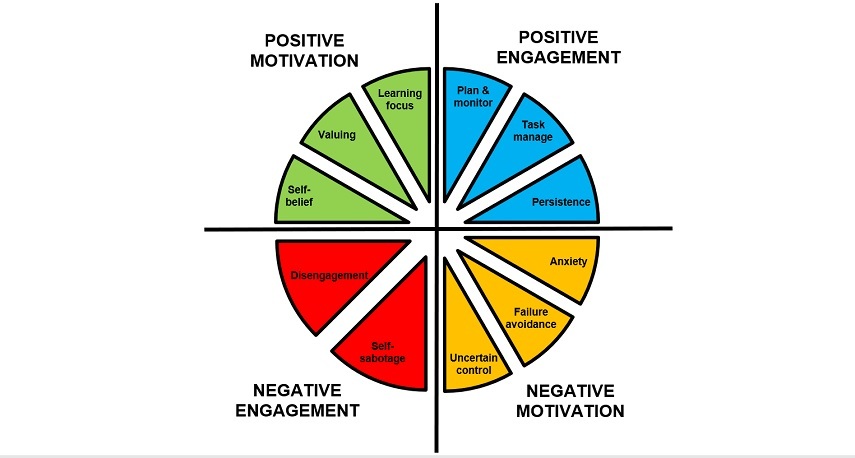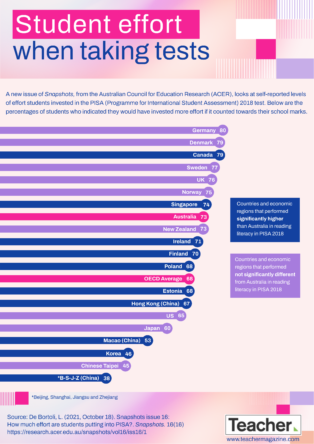To say that teachers have a significant impact on students’ motivation and engagement is not controversial, nor particularly enlightening. Trucks can be filled with the research papers that show this.
A more informative exercise is to dig into how teachers impact students’ motivation and engagement. This provides practical direction for educators seeking to sustain the students who are motivated and engaged and to better support the students who are not.
There are four ways that teachers shape students’ motivation and engagement:
- Knowing and targeting the key parts of motivation and engagement;
- Applying instructional strategies that boost motivation and engagement;
- Building good teacher-student relationships; and,
- Participating in high quality professional learning purposefully focused on motivation and engagement
Knowing and targeting the key parts of motivation and engagement
Motivation and engagement are multidimensional. Knowing their major components is vital for sustaining students’ motivation and engagement strengths and addressing any motivation and engagement difficulties students might have.
Over 20 years ago, I developed the Motivation and Engagement Wheel as a way for educators to understand the positive and negative parts of students’ motivation and engagement.

[Motivation and Engagement Wheel (reproduced with permission and downloadable from www.lifelongachievement.com)]
As can be seen, the Wheel has four overarching themes, each comprising specific motivation and engagement facets.
Positive Motivation
- Self-belief: students’ belief and confidence in their ability to understand or to do well in schoolwork.
- Valuing: how much students believe what they learn at school is useful, relevant, meaningful, and important.
- Learning focus: being interested in learning, developing new skills, improving, understanding new things, and doing a good job for its own sake and not just for rewards or marks.
Positive Engagement
- Planning and monitoring: how much students plan assignments, homework and study, and how much they keep track of their progress.
- Task management: how students use their study or homework time, organise a study or homework timetable, and choose and arrange where they study or do homework.
- Persistence: how much students keep trying to work out an answer or to understand a problem, even if that problem is difficult or challenging.
Negative Motivation
- Anxiety: the extent to which students feel nervous and/or worry when they think about or do their schoolwork, assignments, or exams.
- Failure avoidance: when the main reason students do their schoolwork is to avoid doing poorly or disappointing others.
- Uncertain control: when students are unsure how to do well or how to avoid doing poorly.
Negative Engagement
- Self-sabotage: when students do things that reduce their success at school, such as procrastinating or investing little or no effort when an assessment or performance approaches.
- Disengagement: students’ thoughts and feelings of giving up, detaching from school and schoolwork, and helplessness.
The task for teachers is to know where their students sit on each part of the Wheel and then increase the positive motivation and engagement factors and reduce the negative ones. I have developed resources for assessing students on the Wheel (the Motivation and Engagement Scale) and for helping students improve on each part of the Wheel (the Student Motivation and Engagement Booster Program).
Applying instructional strategies
How teachers teach also impacts students’ motivation and engagement. For decades there has been something of a tussle between explicit instruction and constructivist teaching (e.g., discovery learning). I have proposed Load Reduction Instruction (LRI) to get the optimal balance between these two approaches. LRI has five principles to guide teaching:
- Reduce difficulty during the initial stages of learning, as appropriate to the student’s level of existing knowledge;
- Provide instructional support and scaffolding during learning;
- Give ample time to structured practice, rehearsal, and revision;
- Provide feedback-feedforward that shows students how to improve; and,
- Encourage independent practice and guided autonomy when students have acquired the necessary skill and knowledge.
When teachers apply these five principles, students are more likely to keep up with the lesson, more likely to understand what they are taught, and less likely to get lost or confused. This fuels their motivation and engagement. Research using the Motivation and Engagement Scale has shown that LRI enhances the key dimensions of students’ motivation and engagement (Martin & Evans, 2018).
Building good teacher-student relationships
Teachers also impact motivation and engagement through the relationships they build with their students. Again, using the Motivation and Engagement Scale, research has shown that teachers’ positive connections with students yield higher scores on the positive motivation and engagement factors and lower scores on the negative ones (Martin et al., 2009). I have developed Connective Instruction as a practical means for teachers to embed quality relationships into the everyday course of pedagogy. There are three key relationships to cultivate in Connective Instruction:
- Interpersonal relationship – developed through warmth and emotional support;
- Substantive relationship – developed through content and tasks that engage and connect with students; and,
- Pedagogical relationship – developed through the teacher’s communication and explanation of subject matter.
Participating in high quality professional learning
Professional learning (such as in-servicing) is important for enhancing students’ educational outcomes, including their motivation and engagement. Unfortunately, the quality of professional learning can be variable. There are numerous reasons for this, but three are worth noting: There is often a poor evidence-base underpinning the professional learning; it is too general, lacking in concreteness and specificity; and it is typically one-off and short-lived.
This is where professional learning focused on the Wheel can be helpful. First, it has a strong theoretical and evidence base. Second, it specifically identifies the key parts of motivation and engagement that teachers need to attend to. Third, being a multidimensional framework, sustained professional learning can be conducted so that teachers can systematically work through each part of the Wheel.
A final thought
Motivation and engagement are learnable and changeable. Through the above four practical approaches, teachers can feel more confident in sustaining those students who are motivated, engaged, and travelling well – and better supporting those who are struggling.
References
Martin, A. J., Marsh, H. W., McInerney, D. M., & Green, J. (2009). Young people's interpersonal relationships and academic and nonacademic outcomes: Scoping the relative salience of teachers, parents, same-sex peers, and opposite-sex peers. Teachers College Record, 111, 13. https://www.researchgate.net/publication/281156323_Young_people's_interpersonal_relationships_and_academic_and_nonacademic_outcomes_Scoping_the_relative_salience_of_teachers_parents_same-sex_peers_and_opposite-sex_peers
Martin, A.J., & Evans, P. (2018). Load Reduction Instruction: Exploring a framework that assesses explicit instruction through to independent learning. Teaching and Teacher Education, 73, 203-214. https://www.researchgate.net/publication/324684073_Load_Reduction_Instruction_Exploring_a_Framework_that_Assesses_Explicit_Instruction_through_to_Independent_Learning
Further resources
Motivation and Engagement: Martin, A.J. (1999-22). Motivation and Engagement Scale; Motivation and Engagement Student Booster; Motivation and Engagement Staff Trainer. www.lifelongachievement.com
Load Reduction Instruction in Practice: Martin, A. (2018). Integrating explicit instruction with independent learning: Load Reduction Instruction (LRI). Australian Educational Leader, 40(2), 36-39. https://www.researchgate.net/publication/327337595_Integrating_explicit_instruction_with_independent_learning_Load_Reduction_Instruction_LRI_In_%27Australian_Educational_Leader%27
Teacher-Student Relationships in Practice: Martin, A.J. (2013). Connective Instruction Worksheets. https://lifelongachievement.com/pages/download-corner.
More research and practice publications on topics discussed in this article can be accessed via Andrew Martin’s ResearchGate account: https://www.researchgate.net/profile/Andrew-Martin-22



